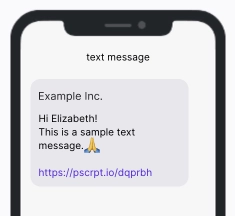Table of Contents
SMS marketing is a strong competitor to email marketing.
Both are examples of direct marketing channels, where a business can market their products directly to their newsletter subscribers.
And although email and SMS share overlapping features such as automated workflows and broadcast campaigns, SMS is unlikely replace email.
To understand why email is still the most widely-used direct marketing channel, let’s look at the strengths and weaknesses of both:
Character Limits
SMS messages are limited to 160 characters per message, so if you exceed this limit you’ll have to pay more for your campaign (see costs below).
Also, including an emoji or special character (such as “é”) will reduce this limit to 70 characters per message.
Not to mention you’ll likely need to include a link to your website as part of your call to action, which uses up a chunk of your character count. Thankfully some SMS marketing apps like Postscript.io automatically shorten your links.

This message includes an emoji and is over 70 characters, so it would be billed as 2 SMS messages per recipient.
Emails, however, do not have any character limits.
You’re free to use as many characters as you like, regardless of whether they’re emojis or not.
Winner: Email
Click-Through-Rates & Brevity
Although SMS has tight character limits, this forces marketers to write thoughtful and shorter messages.
Many believe that the brevity of SMS is what makes it easier to click through, compared to email.
In fact, SMS averages a 36% click-through-rate (source), compared to email’s 2.5% CTR (source).
Winner: SMS
Costs
The cost of sending emails and SMS varies between different platforms and apps. SMS rates also depend on the recipient’s geographic location.
For example, we have clients that use Postscript, which currently costs about $0.0007 USD per message in Canada or the US, but would cost $0.045 for recipients anywhere else in the world.
On the other hand, apps like Klaviyo include both email and SMS plans, where you’re able to send a fixed number of messages per month.
However, SMS boasts a conversion rate nearly doubled that of email (29% vs 15% — source).
Although this depends on many things, especially size of each list, SMS will often see a greater ROI than email.
Winner: SMS
Messaging Experience
Not only is SMS more direct than email, it also offers a more personal experience.
Which is why brands also use SMS as a customer support channel, in addition to sending promotional messages.
Although both SMS and email can be used for two-way conversations with customers, SMS provides a more personal touch, whereas email is easier to manage at large volumes.
While both channels have their own use cases the personal touch of SMS gives it a slight advantage, especially when you consider than SMS averages an overall higher conversion rate than email.
Winner: SMS
Opt-In Rates
Because SMS is more personal than email, people are often less likely to give away their phone numbers.
In today’s age of data privacy, people are more protective of their personal information than ever (and rightfully so).
Many people use secondary email addresses to protect their identities (especially Gen Z and Millennials), but few people have multiple phone numbers.
This is probably why we’ve observed our clients’ email lists to be 15x larger than their SMS lists, on average.
Winner: Email
Multimedia
Visual elements adds a lot of appeal to marketing, and email technology supports images and GIFs better than SMS.
The advantage of SMS is based on fast and short instant messages (SMS is actually short for “Short Message Service”) but you also have the option to include an image or GIF.
When you add media to an SMS you’ll have to send an MMS — short for “Multimedia Message Service”.
MMS is more costly than SMS though, and the nuances to using MMS is very different from emails with images.
Winner: Email
Accessibility
Since SMS is sent through a cellular network, it doesn’t rely on an internet connection.
These days, though, a 5G, LTE or similar mobile data networks are everywhere.
Most metropolitan cities offer free public WiFi, even in subway stations — where cellular networks would lose signal.
Currently, 56% of the world’s population lives in cities (source). As urbanization is expected to continue, this number will only keep growing.
For now though, the accessibility of email and SMS really just depends on where you live.
Winner: Tie
Turnaround Time
The real reason why marketers love SMS is because it’s just so much easier to develop than emails, especially HTML emails and especially when you have picky clients (you know who you are 👀☕).
Marketing emails are way more structured than SMS; it requires thorough quality assurance testing to make sure it renders properly on different devices, across different inbox providers.
Whereas SMS is usually pure copy, and even then it’s way more brief than email.
Winner: SMS
Regulations
Just like with emails, the data privacy movement has regulated the world of SMS marketing.
A lot of the same rules and best practices from email regulations also apply to SMS, with some additions:
- unlike with email marketing in Canada and the US, users must give explicit consent for SMS marketing
- SMS cannot be used for transactional purposes unless given explicit consent
- cart recovery messages must be sent within 48 hours since the event trigger, and you’re limited to only 1 message per flow
- SMS has quiet hours, meaning you’re not allowed to send any messages late at night, or early in the morning
- the actual hours vary between different states and regions
- a good rule of thumb is to never send SMS between 9pm to 9am, local time
Although these requirements are within reason, they do add some restrictions for SMS marketing.
Winner: Email
Conclusion
Based on the comparisons above, it’s clear that SMS and email have different strengths and weaknesses, despite being very similar in nature.
While email marketing is well-rounded, SMS is far better at marketing to your most loyal patrons.
You may be tempted to neglect one in favour of the other, and it’s certainly possible to grow a brand with only one of these channels.
But the technique that successful brands use is to nurture brand enthusiasts with email marketing, so that they’re comfortable with joining your SMS list.
Managing both channels can prove to be very demanding, which is why many marketing agencies resell our white-label marketing services so that they can focus on delivering the best client experience.
